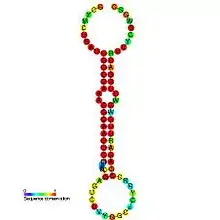mir-219 microRNA precursor family
In molecular biology, the microRNA miR-219 was predicted in vertebrates by conservation between human, mouse and pufferfish and cloned in pufferfish.[1] It was later predicted and confirmed experimentally in Drosophila.[2] Homologs of miR-219 have since been predicted or experimentally confirmed in a wide range of species, including the platyhelminth Schmidtea mediterranea, several arthropod species and a wide range of vertebrates (MIPF0000044). The hairpin precursors (represented here) are predicted based on base pairing and cross-species conservation; their extents are not known. In this case, the mature sequence is excised from the 5' arm of the hairpin.
| mir-219 microRNA precursor family | |
|---|---|
 Predicted secondary structure and sequence conservation of mir-219 | |
| Identifiers | |
| Symbol | mir-219 |
| Rfam | RF00251 |
| miRBase | MI0000296 |
| miRBase family | MIPF0000044 |
| Other data | |
| RNA type | Gene; miRNA |
| Domain(s) | Eukaryota |
| GO | GO:0035195 GO:0035068 |
| SO | SO:0001244 |
| PDB structures | PDBe |
miR-219 has also been linked with NMDA receptor signalling in humans by targeting CaMKIIγ (a kind of protein kinase dependent to calcium and calmodulin) expression. And it has been suggested that deregulation of this miRNA can lead to the expression of mental disorders such as schizophrenia.[3] Recent findings show that miR-219 is linked with Tau toxicity, suggesting that miR-219 is involved in neurodegenerative disease, such as Alzheimer's disease, Parkinson's disease etc.[4]
References
- Lim LP, Glasner ME, Yekta S, Burge CB, Bartel DP (March 2003). "Vertebrate microRNA genes". Science. 299 (5612): 1540. doi:10.1126/science.1080372. PMID 12624257.
- Lai EC, Tomancak P, Williams RW, Rubin GM (2003). "Computational identification of Drosophila microRNA genes". Genome Biology. 4 (7): R42. doi:10.1186/gb-2003-4-7-r42. PMC 193629. PMID 12844358.
- Kocerha J, Faghihi MA, Lopez-Toledano MA, Huang J, Ramsey AJ, Caron MG, Sales N, Willoughby D, Elmen J, Hansen HF, Orum H, Kauppinen S, Kenny PJ, Wahlestedt C (March 2009). "MicroRNA-219 modulates NMDA receptor-mediated neurobehavioral dysfunction". Proceedings of the National Academy of Sciences of the United States of America. 106 (9): 3507–12. doi:10.1073/pnas.0805854106. PMC 2651305. PMID 19196972.
- Santa-Maria I, Alaniz ME, Renwick N, Cela C, Fulga TA, Van Vactor D, Tuschl T, Clark LN, Shelanski ML, McCabe BD, Crary JF (February 2015). "Dysregulation of microRNA-219 promotes neurodegeneration through post-transcriptional regulation of tau". The Journal of Clinical Investigation. 125 (2): 681–6. doi:10.1172/JCI78421. PMC 4319412. PMID 25574843.
External links
- Page for mir-219 microRNA precursor family at Rfam
- MIPF0000044
- MicroRNA of the month at the miRNA blog